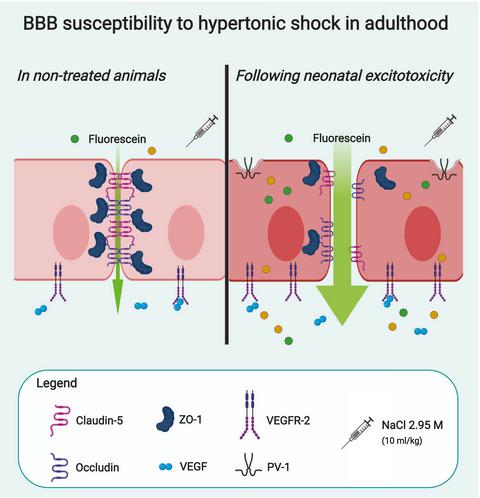当前位置:
X-MOL 学术
›
Int. J. Dev. Neurosci.
›
论文详情
Our official English website, www.x-mol.net, welcomes your
feedback! (Note: you will need to create a separate account there.)
Neonatal excitotoxicity modifies blood-brain barrier properties increasing its susceptibility to hypertonic shock in adulthood
International Journal of Developmental Neuroscience ( IF 1.7 ) Pub Date : 2020-04-01 , DOI: 10.1002/jdn.10027 Blanca Fabiola Fajardo-Fregoso 1 , Jose Luis Castañeda-Cabral 1 , Carlos Beas-Zárate 1 , Mónica E Ureña-Guerrero 1
International Journal of Developmental Neuroscience ( IF 1.7 ) Pub Date : 2020-04-01 , DOI: 10.1002/jdn.10027 Blanca Fabiola Fajardo-Fregoso 1 , Jose Luis Castañeda-Cabral 1 , Carlos Beas-Zárate 1 , Mónica E Ureña-Guerrero 1
Affiliation

|
Early responses to a neurological excitotoxic process include blood‐brain barrier (BBB) impairment and overexpression of vascular endothelial growth factor (VEGF), but the long‐term effects of excitotoxicity on the BBB properties remain unknown. To assess this, we induced an excitotoxic process on male rats by neonatal monosodium glutamate (MSG) treatment. At postnatal day (PD) 60, we measured the expression level of structural proteins of the BBB and the VEGF type‐2 receptor (VEGFR‐2) protein in the cerebral motor cortex (CMC), striatum (STR), hippocampus (Hp), entorhinal cortex (Ent), and hypothalamus (Hyp). We also measured BBB permeability in the same cerebral regions. Neonatal MSG treatment significantly reduced the protein expression level of claudin‐5 in the CMC, and of ZO‐1 in the CMC and Hp, and increased the expression level of plasmalemmal vesicle‐associated protein in the CMC, and of VEGFR‐2 in all regions except for the Hyp. BBB permeability was significantly higher in all studied regions of MSG‐treated animals after hypertonic shock (HS). The increased BBB permeability observed in the MSG‐treated animals after HS was reversed by VEGFR‐2 inhibition with SU5416. We conclude that neonatal excitotoxicity leads to lasting impairment on BBB properties in adulthood, increasing its susceptibility to HS that could be regulated by VEGFR‐2 activity inhibition.
中文翻译:

新生儿兴奋性毒性改变血脑屏障特性,增加其在成年期对高渗性休克的易感性
对神经兴奋性毒性过程的早期反应包括血脑屏障 (BBB) 损伤和血管内皮生长因子 (VEGF) 的过度表达,但兴奋性毒性对 BBB 特性的长期影响仍然未知。为了评估这一点,我们通过新生儿谷氨酸钠 (MSG) 治疗对雄性大鼠诱导了兴奋性毒性过程。在产后第 60 天 (PD),我们测量了大脑运动皮层 (CMC)、纹状体 (STR)、海马 (Hp) 中 BBB 结构蛋白和 VEGF 2 型受体 (VEGFR-2) 蛋白的表达水平、内嗅皮层 (Ent) 和下丘脑 (Hyp)。我们还测量了相同大脑区域的 BBB 通透性。新生儿味精治疗显着降低了 CMC 中 claudin-5 的蛋白表达水平,以及 CMC 和 Hp 中 ZO-1 的蛋白表达水平,并增加了 CMC 中质膜囊泡相关蛋白的表达水平,以及除 Hyp 之外的所有区域中 VEGFR-2 的表达水平。在高渗休克 (HS) 后,MSG 治疗动物的所有研究区域的 BBB 通透性显着更高。在 HS 后用味精处理的动物中观察到的 BBB 通透性增加被 SU5416 抑制 VEGFR-2 逆转。我们得出结论,新生儿兴奋性毒性导致成年期 BBB 特性的持续损害,增加其对 HS 的易感性,这可能受 VEGFR-2 活性抑制的调节。在 HS 后用味精处理的动物中观察到的 BBB 通透性增加被 SU5416 抑制 VEGFR-2 逆转。我们得出结论,新生儿兴奋性毒性导致成年期 BBB 特性的持续损害,增加其对 HS 的易感性,这可能受 VEGFR-2 活性抑制的调节。在 HS 后用味精处理的动物中观察到的 BBB 通透性增加被 SU5416 抑制 VEGFR-2 逆转。我们得出结论,新生儿兴奋性毒性导致成年期 BBB 特性的持续损害,增加其对 HS 的易感性,这可能受 VEGFR-2 活性抑制的调节。
更新日期:2020-04-01
中文翻译:

新生儿兴奋性毒性改变血脑屏障特性,增加其在成年期对高渗性休克的易感性
对神经兴奋性毒性过程的早期反应包括血脑屏障 (BBB) 损伤和血管内皮生长因子 (VEGF) 的过度表达,但兴奋性毒性对 BBB 特性的长期影响仍然未知。为了评估这一点,我们通过新生儿谷氨酸钠 (MSG) 治疗对雄性大鼠诱导了兴奋性毒性过程。在产后第 60 天 (PD),我们测量了大脑运动皮层 (CMC)、纹状体 (STR)、海马 (Hp) 中 BBB 结构蛋白和 VEGF 2 型受体 (VEGFR-2) 蛋白的表达水平、内嗅皮层 (Ent) 和下丘脑 (Hyp)。我们还测量了相同大脑区域的 BBB 通透性。新生儿味精治疗显着降低了 CMC 中 claudin-5 的蛋白表达水平,以及 CMC 和 Hp 中 ZO-1 的蛋白表达水平,并增加了 CMC 中质膜囊泡相关蛋白的表达水平,以及除 Hyp 之外的所有区域中 VEGFR-2 的表达水平。在高渗休克 (HS) 后,MSG 治疗动物的所有研究区域的 BBB 通透性显着更高。在 HS 后用味精处理的动物中观察到的 BBB 通透性增加被 SU5416 抑制 VEGFR-2 逆转。我们得出结论,新生儿兴奋性毒性导致成年期 BBB 特性的持续损害,增加其对 HS 的易感性,这可能受 VEGFR-2 活性抑制的调节。在 HS 后用味精处理的动物中观察到的 BBB 通透性增加被 SU5416 抑制 VEGFR-2 逆转。我们得出结论,新生儿兴奋性毒性导致成年期 BBB 特性的持续损害,增加其对 HS 的易感性,这可能受 VEGFR-2 活性抑制的调节。在 HS 后用味精处理的动物中观察到的 BBB 通透性增加被 SU5416 抑制 VEGFR-2 逆转。我们得出结论,新生儿兴奋性毒性导致成年期 BBB 特性的持续损害,增加其对 HS 的易感性,这可能受 VEGFR-2 活性抑制的调节。











































 京公网安备 11010802027423号
京公网安备 11010802027423号